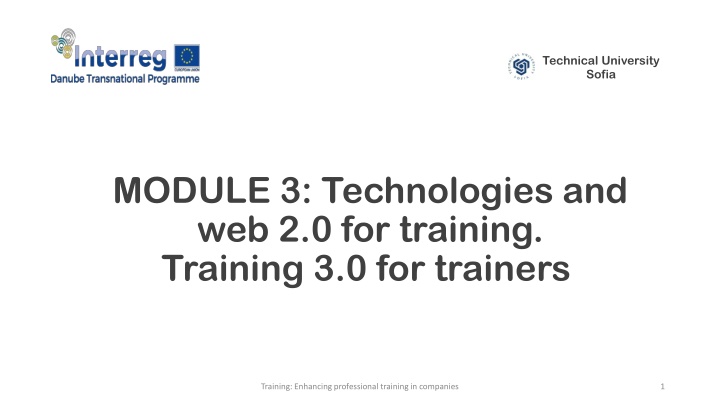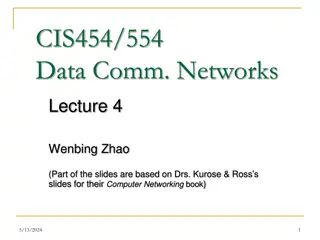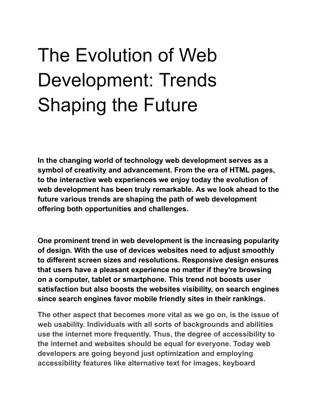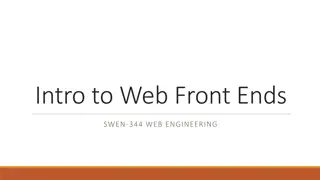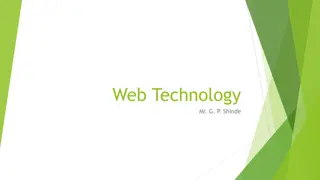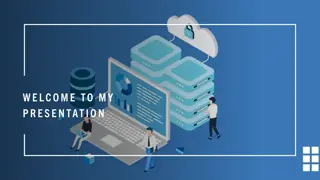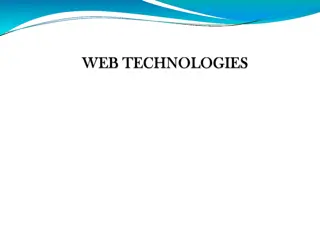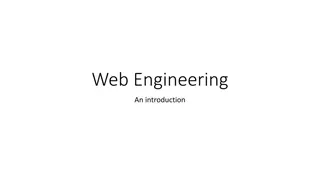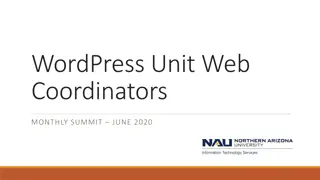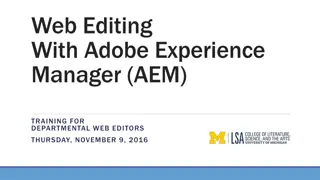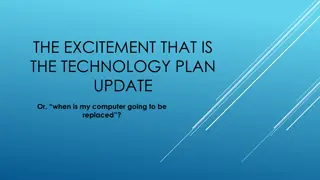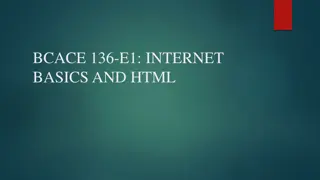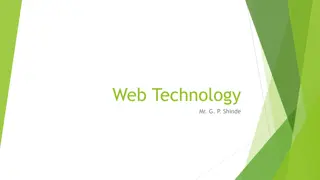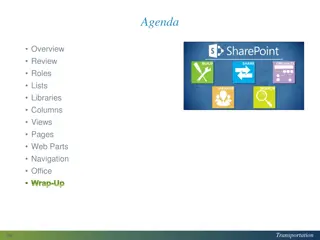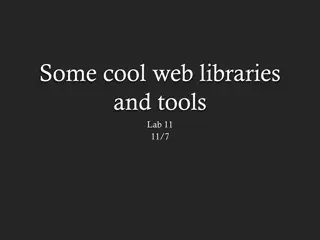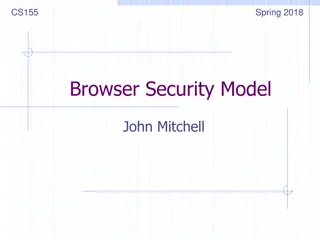Enhancing Professional Training with Technology and Web 2.0
Discover how the Training 3.0 program at Technical University Sofia empowers trainers with modern technologies, web-based tools, and social computing. Dive into LMS, simulations, and more to enhance professional training in companies. Explore e-learning, mobile learning, and cloud-based solutions revolutionizing corporate training methods for maximal efficiency.
Download Presentation

Please find below an Image/Link to download the presentation.
The content on the website is provided AS IS for your information and personal use only. It may not be sold, licensed, or shared on other websites without obtaining consent from the author.If you encounter any issues during the download, it is possible that the publisher has removed the file from their server.
You are allowed to download the files provided on this website for personal or commercial use, subject to the condition that they are used lawfully. All files are the property of their respective owners.
The content on the website is provided AS IS for your information and personal use only. It may not be sold, licensed, or shared on other websites without obtaining consent from the author.
E N D
Presentation Transcript
Technical University Sofia MODULE 3: Technologies and web 2.0 for training. Training 3.0 for trainers Training: Enhancing professional training in companies 1
Course: Training of trainers` competency model Module 1: Competencies and competency models for the trainers of 21st Century Module 2: Training methodology. Need analyze. Knowledge management. Module 3: Technologies and web 2.0 for training. Training 3.0 for trainers Module 4: Pedagogy 2.0 and e-portfolio in training. Feedback Module 5: Training delivery, evaluation and efficiency Training: Enhancing professional training in companies 2
Objectives After completing the Technology module, participants will acquire knowledge about LMS, will have an understanding about the use of simulations technologies, web based tools and training 2.0, and social computing tools applicable to learning and training. Training: Enhancing professional training in companies 3
Content Introduction Learning Technology - LMS Web 2.0 Learning and training 2.0 Social Computing Tools applicable to learning and training Training: Enhancing professional training in companies 4
Experience is Better Than Theory Introduction What is Learning 2.0? What is LMS? Training: Enhancing professional training in companies 5
Training points in tech context Learning and development (L&D) departments striving to meet business objectives efficiently are constantly looking for ways to maximise their return on training investment. Using Blended Learning Techniques Outsource Training Instructions Training Content - a Priority Investing in e-Learning and Technology ROI for training Training: Enhancing professional training in companies 6
E-Learning E-learning can be defined as the use of computer and Internet technologies to deliver a broad array of solutions to enable learning and improve performance. Training: Enhancing professional training in companies 7
Technology Mobile learning Cloud-based LMS Video-based training Technology is revolutionizing corporate learning methods and tactics, enabling organizations to engage with their employees in the most effective way. Virtual environment and avatars - simulations Education data mining Training Technology HTML 5 and responsive design Big Data Automation and adaptive learning Digital reader Training: Enhancing professional training in companies 8
Simulations technologies Simulation-based training aims to reduce errors and cost and address knowledge and skill gaps. Simulator development technologies can generate realistic scenarios that allow employees to react properly to injuries and workplace damage. How technology can support and enhance the training process and what digital learning resources can intensify knowledge transformation? Training: Enhancing professional training in companies 9
Learning Management System (LMS) A learning management system (LMS) is a software application for: Administration Documentation Tracking Reporting Delivery of educational courses or training programs. Training: Enhancing professional training in companies 10
Some LMS Features Asynchronous Learning Blended Learning Built-In Course Authoring Certification Management Gamification Gradebook Mobile Learning Skills Tracking Social Learning Student Portal Synchronous Learning Testing / Assessments Video Conferencing Training: Enhancing professional training in companies 11
LMS software Training: Enhancing professional training in companies 12
Learning Concepts Microlearning Gamification Learning 2.0 Immersive Learning Personalized learning Training: Enhancing professional training in companies 13
New Learning Concepts Microlearning is the concept of delivering content to learners in small, specific bursts over time or just when needed. This has led to short how- to-videos that last less than five minutes and to small text message-based instruction. Gamification is a large trend that appears to be growing in both use and acceptance. Using a combination of the science of motivation, distributed learning, and other neuroscience foundations, gamification takes advantage of game elements to engage learners. Training: Enhancing professional training in companies 14
Learning Concepts Learning 2.0 Personalized learning is instruction that adapts and changes based on individual learner inputs and actions. Immersive Learning consists of different facets of the same concept that are making learning more immersive. One of the most interesting factors is the emergence of virtual experiences in real-time through the use of such devices as the Oculus Rift and the ingeniously simple Google Cardboard. Training: Enhancing professional training in companies 15
Education 1.0 - Education 3.0 Future learning environments capitalize on the potential of Web 2.0 by combining social software tools with connectivist pedagogical models. The evolution of the web from Web 1.0 to Web 2.0 and now to Web 3.0 can be used a metaphor of how education should also be evolving, as a movement based on the evolution from Education 1.0 to Education 3.0. Moving from Education 1.0 Through Education 2.0 Towards Education 3.0 Training: Enhancing professional training in companies 16
Education 3.0 Similar to Web 2.0, Education 2.0 includes more interaction between the teacher and student; student to student; and student to content/expert. Some educators have moved into a more connected, creative Education 2.0 through using cooperative learning, global learning projects, shared wikis, blogs and other social networking in the classroom. Education 3.0 is a connectivist, heutagogical approach to teaching and learning. The teachers, learners, networks, connections, media, resources, tools create a unique entity that has the potential to meet individual learners , educators , and even societal needs. Many resources for Education 3.0 are literally freely available for the taking. Training: Enhancing professional training in companies 17
Education 3.0 1. Meaning is social constructed and contextually reinvented 2. Technology is everywhere (digital universe). 3. Teaching is done teacher-to-student, student-to-student, and people- technology-people (co-constructivism) 4. Schools are located everywhere (fully infused in society) 5. Parents view schools as a place for them to learn, too 6. Teachers are everybody, everywhere 7. Hardware and software in schools are available at low cost and are used (strategically) 8. Industry views graduates as co-workers or entrepreneurs Training: Enhancing professional training in companies 18
Web 2.0 for learning and training Web based tools Authoring tools Augmented reality Training: Enhancing professional training in companies 19
Web 2.0 The web 2.0 technologies gives the learner ability to combine text, audio and video content with online learning spaces, electronic communication, web-based conferencing systems, simulation software, social media and live synchronous tools is delivering flexible learning opportunities. Training: Enhancing professional training in companies 20
Learning 2.0 Learning 2.01 approaches promote the technological, pedagogical and organisational innovation in formal E&T. 1. Learning 2.0: The Impact of Web 2.0 Innovations on Education and Training in Europe Training: Enhancing professional training in companies 21
Social Computing Tools Web 2.0 or social computing (a term we prefer to use in this report) refers to the range of digital applications that enable interaction, collaboration and sharing between users. Such digital applications include those for blogging, podcasting, collaborative content (e.g. wikis), social networking (e.g. MySpace, Facebook), multimedia sharing (e.g. Flickr, YouTube), social tagging (e.g. Deli.cio.us) and social gaming (e.g. Second Life)1. 1. Review of Learning 2.0 Practices: Study on the Impact of Web 2.0 Innovations on Education and Training in Europe Training: Enhancing professional training in companies 22
Social networking services Social networking services can be broadly defined as internet- or mobile- device-based social spaces designed to facilitate communication, collaboration and content sharing across networks of contacts. Training: Enhancing professional training in companies 23
Syndication and notification technologies Syndication is a means of having an update on changing content from a given web source sent directly to you, rather than you having to go and check this site on a regular basis. Training: Enhancing professional training in companies 24
Blogs Weblogs or blogs , a term coined by Jorn Barger in 1997, are online public writing environments, which enable a single author or a group of authors to write and publicly display articles, called posts, which are listed in reversed chronological order. Training: Enhancing professional training in companies 25
Wikis A wiki is a website that allows users to collaboratively add, remove and otherwise edit and change content, usually text. Unlike blogs, wikis generally have a history function, which allows previous versions to be examined, and a rollback function, which restores previous versions. Training: Enhancing professional training in companies 26
Tagging, social bookmarking and folksonomies A social bookmarking service allows users to record (bookmark) web pages, and tag those records with significant words (tags) that describe the pages being recorded. Examples include del.icio.us, furl and Bibsonomy. This process of organising information through user-generated tags has become known as folksonomy . Training: Enhancing professional training in companies 27
Media-sharing services, podcasts and vodcasts Media-sharing devices store user-contributed media, and allow users to search for and display content. Training: Enhancing professional training in companies 28
Podcasts and vodcasts Podcasting is a way in which a listener may conveniently keep up-to-date with recent audio or video content; vodcasts are video versions of podcasts. Podcasting and Vodcasting are powerful tools that allow the communication and distribution of educational content. Training: Enhancing professional training in companies 29
Virtual worlds and immersive environments Virtual environments, like Second Life, or similar online 3-D virtual worlds, such as Active Worlds, Entropia Universe, and Dotsoul Cyberpark provide users with a online gamelike 3D digital environment to which users subscribe. Training: Enhancing professional training in companies 30
Online office applications Online office applications, also called Web office , Web desktop or WebTop (as opposed to desktop ) are software packages, that replicate desktop applications like Microsoft Office or Open Office, usually including a word processor, data sheet, multimedia presentations, etc. Training: Enhancing professional training in companies 31
Technical University Sofia Experience is Better Than Theory Happy lifelong learning! Training: Enhancing professional training in companies 32
